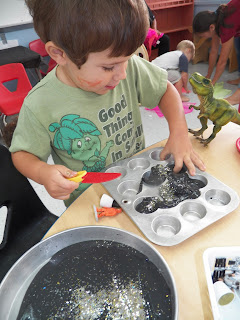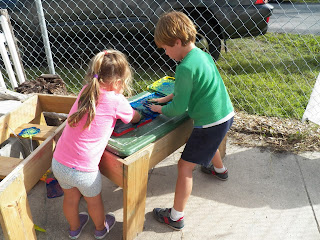Perspective.
Debate class was one of my favorite classes in High School.
Until 9th grade, it never dawned on me that I could argue in favor of an issue that I really didn't believe in.
As a matter of fact, I found that I enjoyed the experience of looking at issues from a new perspective.
I am guessing there is a more technical term for this concept..but as you know, I ended up as a teacher, not an attorney.
Working with caregivers and parents and their children offers me many new perspectives each day.
I design and arrange many different experiences for children with the HOPE that I will be OPEN to their perspectives.
Wonder Studio only continues as I evolve my program to mirror the child's perspective.
There could be some who say that the Arts are all about "Perspective". Each person contributes and interprets the arts through his/her own experience and perspective.
For example, when I sing with a group, I feel great. I couldn't be happier. My brain is most likely attempting to hit the notes, keep up the melody, etc...but in my heart, singing is like breathing. It's an automatic process that just seems to happen on it's own.
However, when I see or hear a recording of myself singing...I cringe and think to myself..."Is that really what I sound like?"
It's usually quite shocking.
My perspective is quite affected and even clouded by my fear of being judged by others.
There is no true perspective through fear.
And, that in itself...is pretty scary.
Every caregiver worries. And worry comes from our fears.
We fear that something is wrong with our child.
We fear that we will fail our children.
We fear that we will be judged by others based on our child's behavior.
Fear and Judgement. The enemy to Perspective.
A wonderful and caring nanny asked me the other day...what should she do about her "bull in a china shop" toddler that she is caring for while he is at Wonder Studio?
I am going to paraphrase here...but she had some fears...
What if he hurts one of the other children?
What if he takes away from the experience of the other children?
What if he needs more structure?
What if he needs more guidance?
Of course, in the midst of our conversation...he runs over to a little girl and hits her upside the head.
After, talking it though with he and the little girl...
Nanny and I continued our conversation.
In my drawing and Painting classes the teacher often asked us to look at our pieces from a new perspective, especially when you found yourself "Stuck".
Turn it upside down...
Look at it really close...
Look at it really far away...
I think I really love that about Art.
It is all about finding a new way to look at something.
I think that caregiving and parenting can be like this too.
Sometimes, it's good to have a new perspective.
How can we offer ourselves a new perspective on our children?
I am thinking of the movie Forrest Gump when LT. Dan says,
"Get Down! Shut up!" (you know... the part in Vietnam)
So, I think that through Silent Observation...we can begin to see our children with new eyes.
When I asked Nanny if she could sit in one spot and really really try to not "Chase" Mr. Bull all around Wonder Studio...she gave me a look like I was crazy.
I talked her into it.
She observed with an open heart as I played with Mr. Bull for about 10 minutes.
The open heart part is important because when she let go of her "fears" she was able to see him from this new perspective.
At clean up time, she ran over and told me what she had learned.
This new perspective helped her to see the little guy with new eyes. And, it also contributed to how she saw herself as his caregiver.
This is the partnership between caregivers, parents, children, and teachers that I value so very much.
We each play an important part in the upbringing of a child.
I am so thankful to offer a new perspective and I am so very very thankful for
Perspective.
Thursday, October 13, 2016
Sunday, October 9, 2016
Organize the Play Spaces in Your Home with these Tips: Guest Blogger
A Message from our Guest Blogger: Kirsten Fisher!
Kirsten Fisher
Founder and CEO
Imagine Home Organization, LLC
727.251.6449
kfisher@imaginehomeorganization.com
www.imaginehomeorganization.com
Organize the Play Spaces in Your Home with these Tips
Whether you have a designated play room or not, you will likely find there are several places throughout the home where toys, crafts and games will live. Follow these guidelines within each space and you will keep from feeling overwhelmed by the kids’ stuff within the home.

1. Sort Similar Items Together.
Putting all the crayons together and placing with other art and craft supplies will make it easier to find and use when the creative mood strikes. Gathering all Legos, cars, dolls, Play Doh and other items and finding a home for each allows for children to fully engage with an activity because they aren’t searching for all the parts but using their imaginations to create.
2. Containerize.
Find containers for each category of toy that makes sense for you. For example, art supplies might have small containers to keep markers, crayons and pencils separate but then a larger container to house them all together with paper, stickers, scissors and glue. Cars, building blocks and dolls might have open baskets for each. Books may have their own bookshelf (or several in different areas of the home) or sit with other items using bookends or bins. You can be as creative as you want with the containers as long as each item or toy has a home. Containers also allow play time to be mobile. Rather than having to carry all the blocks from the corner to the living room for a family tower contest, you need only carry the bin and then return it to its “home” when the fun is over.
3. Give Everything a Home.
Each toy, crayon, book and monster truck should have a home making cleanup a snap. This is not to say the home is the location where the fun must be contained. Use containers to bring the fun anywhere, just know it goes back home when you are finished.
4. Don’t Forget to Leave Open Space.
Kids need a bit of free space for creativity to flow. Whether they are building a prehistoric dinosaur robot village or adding sparkles to their favorite drawing, transport the items to provide enough space.
5. Make it Comfortable.
Give yourself and your kids seating so it is comfortable to stay, create and play. Child and adult sized seating is important so everyone can enjoy. Seating too is of course mobile.
6. Miscellaneous Bin.
It is OK to have a bin for toys that just don’t confirm to a category. Mine contains special rocks, a tape measure, a tire pressure gage, the latest birthday goodie bag items and a few things I can’t even identify but are precious to the kids.
7. Provide Access.
Use open bins and low shelves for items kids can access on their own. Use higher shelves for things that should have adult supervision. Mid-level shelves might contain things like puzzles and games that are OK if kids reach up and get but are a little more time consuming to pick up.
8. It’s Not About Perfection.
The spaces don’t need to look like they belong in Parenting Magazine as long as they work for you and your kids. You should feel you have an appropriate amount of adult space for your comfort level.
9. Get Outside.
Certain toys can be stored outside and others can come out for maximum enjoyment. I contain most of the toys that stay outside in a large basket on the porch but you could use a small shed or shelves in the garage, especially for more creative items like sand or water tables.
10. Keep Your Home Stocked and Updated.
Every couple of months it is important to go through the kids’ stuff and donate toys that are no longer used or age appropriate. Get rid of dried out markers, broken crayons, used papers and broken toys. Your kids can be a part of this process to learn the importance of giving to others and keeping your own space in order.

Subscribe to:
Comments (Atom)











































